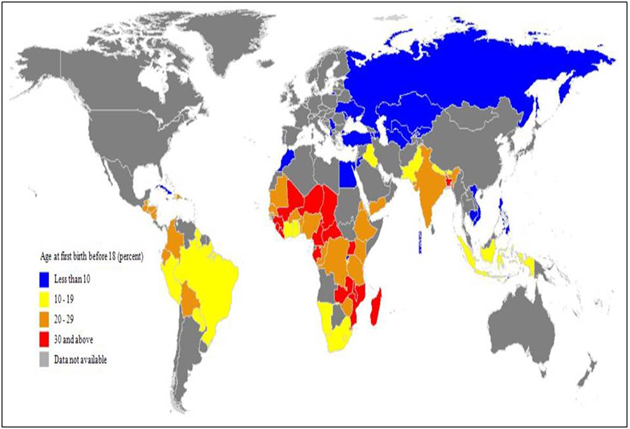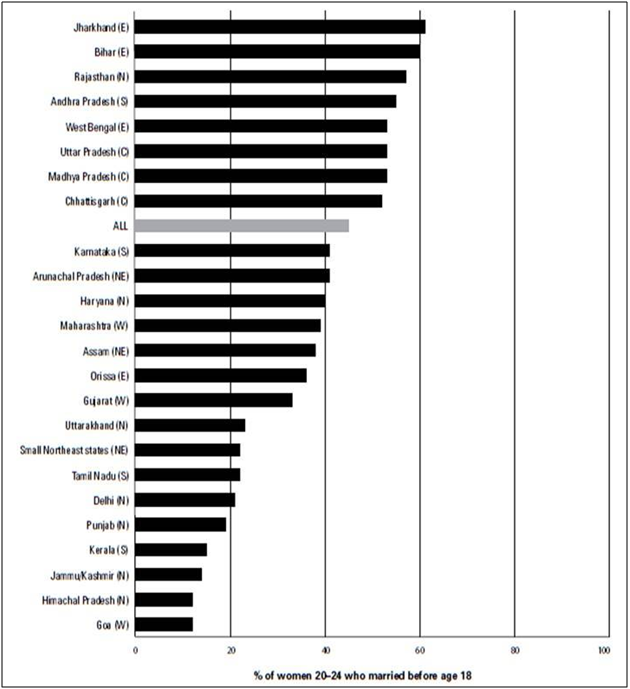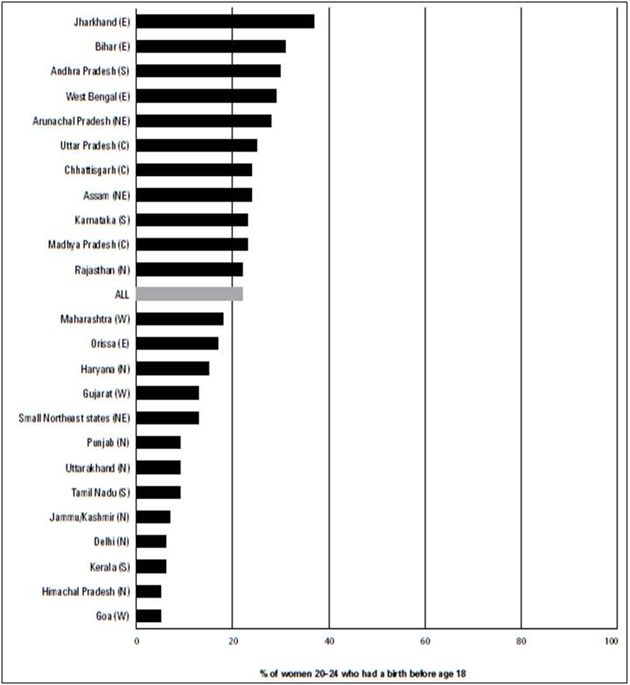eISSN: 2377-4304


Review Article Volume 5 Issue 5
Department of Obstetrics and Gynecology, Maharishi Markandeshwar Institute of Medical Sciences and Research, India
Correspondence: Naina Kumar, Associate Professor, Department of Obstetrics and Gynecology, Maharishi Markandeshwar Institute of Medical Sciences and Research, Mullana, Ambala, Haryana, India, Tel 1-9552515600
Received: October 01, 2016 | Published: December 1, 2016
Citation: Kumar N, Bajaj K. Global facts about wed and unwed adolescent pregnancies and their psychosocial effects: a review of literature. Obstet Gynecol Int J. 2016;5(5):405-410. DOI: 10.15406/ogij.2016.05.00174
Background: Adolescent or teenage pregnancies are serious health issues both for mother as well as for newborn, as it carries grave consequences for both. Though there has been a falling trend in wed or unwed adolescent pregnancies all over the world, especially in developed countries, but still it continues to be a major issue. Adolescent pregnancies usually result from lack of education, poverty, poor awareness and knowledge about contraceptives or fear of using them. Such pregnancies have significant detrimental effects on physical and mental health of mother as well as are associated with poor perinatal outcomes. Hence, present review of literature was carried out to know current trends of adolescent pregnancies all over the world with its psychosocial effects on adolescent mothers.
Methods: Literature regarding adolescent pregnancy was searched from various English language journals, WHO, UNICEF, Guttmacher Institute site and other Governmental sites and published peer‒reviewed articles on Pubmed, MEDLINE, Embase and Google Scholar till 2016.
Keywords: Adolescent, Contraception, Live birth, Teen birth rate, Teenage Pregnancy
According to 2010 data Adolescents constitute around 1.2 billion (18%) of total world population. Of which, 55% resided in Asia and Pacific—with 29% in South Asia alone, including India, and 26% in East Asia and Pacific, including China. It is estimated that by 2030, the adolescent population of Asia and Pacific regions of world will decline to 48% of total, while that of sub‒Saharan Africa will rise to 23% (Figure 1). Also the number of adolescent girls between 10‒17 years will change dramatically, with biggest rise in sub‒Saharan Africa, where adolescent pregnancy is greatest, and rate of contraceptive use is lowest in the world. Hence, the total number of adolescent girls in sub‒Saharan Africa will rise significantly, by 51%, from 75 million in 2010 to 113 million in 2030, and from 18% to 26% of the adolescent girl population in developing societies. If present trend continues, by 2030, the world will have 26 million more adolescent girls, of which majority will belong to Asia and Pacific regions and sub‒Saharan Africa, where they are more prone to face significant higher risks of pregnancy compared to their counterparts in other regions of world.1 The World Health Organization2 defines Teenage Pregnancy as “any pregnancy resulting from a girl 10‒19 years of age”, age being defined as her age at time of birth of baby.3 Latest figures of UNICEF, report that worldwide every 5th child is born to teenage mother.4
The most recent figures indicate that globally almost one in five women aged 20 to 24 (19%) had a live birth by 18 years of age.5 Worldwide 13 million births annually occur to girls younger than 19 years and around 90% of all teenage births occur in developing countries.6 Nevertheless, there is significant variation in teenage pregnancy and birth rates between developed countries also, though the teenage pregnancy and birth rate is considerably lower in developed countries as compared to developing.4 Figure 2 & 3 shows the percentages of women aged 20‒24 who gave birth by age 18.5 It was estimated that in 2010, 36.4 million women aged 20 to 24 had their first live birth before 18 years of age, and 5.6 million before 15 years of age. This is equivalent to 7.3 million girls under 18 years of age giving birth annually, or 20,000 per day. Of 36.4 million, almost half or 17.4 million adolescent mothers belonged to South Asia. Sub‒Saharan Africa on the other hand has the highest prevalence of pregnancies among adolescent girls, accounting for 28% of adolescent mothers, with 15% in West and Central Africa, and 13% in Eastern and Southern Africa.1 Table 1 reveals ten countries with highest percentages and numbers of women aged 20 to 24 who have had a live birth before 18 years of age.5
|
Top 10 countries with the highest percentages of women aged 20‒24 who gave birth by age 18 |
Top 10 countries with the greatest numbers of women aged 20‒24 who gave birth by age 18 |
||
|
Niger |
51% |
India |
11,875,182 |
|
Chad |
48% |
Bangladesh |
2,904,220 |
|
Mali |
46% |
Nigeria |
1,978,365 |
|
Guinea |
44% |
Brazil |
1,354,236 |
|
Mozambique |
42% |
Indonesia |
1,078,955 |
|
Bangladesh |
40% |
Pakistan |
895,449 |
|
Sierra Leone |
38% |
Ethiopia |
881,168 |
|
Liberia |
38% |
DR of the Congo |
757,596 |
|
Central African Republic |
38% |
United republic of Tanzania |
585,949 |
|
Madagascar |
36% |
Kenya |
535,441 |
Table 1 Ten countries with highest percentages and greatest numbers of women aged 20‒24 who have had a live birth<
before age 18, most recent data from surveys since 2000.
[Source: UNFPA MDG5b+Info database with data from DHS and MICS studies (www.devinfo.org/mdg5b). Absolute numbers were estimated using United Nations Population Division, 2010.]
However, over the recent past, global prevalence of pregnancies among girls under 18 years of age has slightly declined, by 14%, from 23.3% to 20.1% except for Latin America and Caribbean regions of world. Maximum declines were reported from Eastern Europe and Central Asia and South Asia of 20%, followed by East Asia and Pacific at 13%. Unfortunately, the overall levels in sub‒Saharan Africa, the Arab States, and Latin America and the Caribbean have remained relatively steady, with changes of less than 10%.1 This declining trend is best revealed by most recent data which showed that as compared to 2014 figures of 24.2 births per 1000 adolescent females ages 15‒19, or 249,078 babies born to females in this age group, there were 229,000 babies born to teenage girls between 15 and 19 years of age in 2015. Also in the year 2014 teen birth rate declined by 9% from 2013 when the birth rate was 26.5 per 1000 adolescent females. Teen birth rate has declined almost continuously over the past 20 years.7 This is best evident by United States data which showed that in 1991, the U.S. teen birth rate was 61.8 births per 1000 adolescent females as compared to 24.2 births per 1000 adolescent females in 2014. From this historic low of 2014, the teen birth rate further declined by 8% in 2015. Hence, between 1991 and 2015, the United States teen birth rate decreased by more than half (from 61.8 to 22.3 per 1000 teens).7 Still, the U.S. teen birth rate is higher than many other developed countries, like Canada and the United Kingdom.8 This decline was mainly due to combination of increased number of adolescents waiting for sexual intercourse and increased use of contraceptives by teens.9,10
Furthermore Teen birth rates differ considerably by age, racial and ethnic group, and region of country. Birth rates were found to be higher among Hispanic and black adolescents than their white counterparts. According to 2014 data, Hispanic adolescent females (15‒19 years) had maximum birth rate (38 births per 1000 adolescent females), followed by black adolescent females (34.9 births per 1000 adolescent females) and white adolescent females (17.3 births per 1000 adolescent females).7
India retains the biggest national adolescent girl population, with hardly any net change to be observed from 2010 to 2030 (93‒95 million). According to latest data of 2010, India had the highest number of women aged 20 to 24 with a live birth before 18 years of age, at 12 million.1 Table 2 shows demographic and reproductive health variables among Indian childbearing age women.11 As per the 2005 figures, India had around 50.5 million adolescent women. The three states accounting for highest female adolescent population included Andhra Pradesh, Maharashtra and Uttar Pradesh, together making for one‒third of all adolescent women in the country, with nearly 16% of them living in Uttar Pradesh alone.12 Within most states of India, 15–19 year‒old women account for at least 10% of the state’s population.13
|
Region (and states) |
Among women 15–49 |
Among women 20–24, % who marry before |
|||||
|
Total fertility rate (lifetime births per woman) |
% with ≥6 yrs. Education |
% living in rural areas |
% using a modern method* |
% of women whose most recent birth† was attended by professional |
Age 18 |
Age 20 |
|
|
North (Delhi, Haryana, Himachal Pradesh, Jammu/Kashmir, Punjab, Rajasthan and Uttarakhand) |
2.64 |
53 |
63 |
54.9 |
54 |
26.8 |
44.9 |
|
Central (Chhattisgarh, Madhya Pradesh and Uttar Pradesh) |
3.53 |
33.5 |
73.9 |
39.5 |
32.9 |
52.9 |
72.5 |
|
East (Bihar, Jharkhand, Orissa and West Bengal) |
2.99 |
36.9 |
76.3 |
40.9 |
37.2 |
51.8 |
70.1 |
|
Northeast (Arunachal Pradesh, Assam, Manipur, Meghalaya, Mizoram, Nagaland, Sikkim and Tripura) |
2.61 |
57.3 |
71.5 |
32.1 |
43.2 |
26.6 |
41.9 |
|
West (Goa, Gujarat and Maharashtra) |
2.21 |
63.5 |
49.8 |
57.7 |
74.2 |
32.4 |
50.9 |
|
South (Andhra Pradesh, Karnataka, Kerala and Tamil Nadu) |
1.88 |
54.9 |
60.3 |
62.7 |
81.2 |
37.1 |
54 |
Table 2 Selected demographic and reproductive health variables among women of childbearing age, by region, India, 2005–2006
*Among married women; modern methods include the pill, IUD, injectables, condoms (male and female),
sterilization (male and female), the diaphragm, foam and jelly.
†Among births in the past three years.
[Source: International Institute for Population Sciences (IIPS) and Macro International, India: National Family Health Survey (NFHS‒3), 2005‒06, Mumbai: IIPS, 2007.]
An estimated 45% of young women in India marry before age 18, the legal age for marriage among women. A majority, 63%, marry before age 20. As of 2006, roughly 8% of all Indian women 20–24 years old became mothers before age 16, when health impact is very high.12 Figure 4 & 5 shows the state‒wise proportion of 20–24‒year‒old women who married and gave birth before age 18.11

Figure 3 Percentages of women aged 20‒24 who gave birth by age 18, by country, most recent data (1996‒2011).
Source: UNFPA MDG5b+Info database with data from DHS and MICS studies ( www.devinfo.org/mdg5b)

Figure 4 Proportion of 20–24‒year‒old women who married before age 18, India overall and all states, 2006.
Note: Letters after state indicate regions: C=Central, E=East, N=North, NE=Northeast, S=South, and W=West.
Source: International Institute for Population Sciences (IIPS) and Macro International, India: National Family Health Survey (NFHS‒3), 2005‒06, Mumbai: IIPS, 2007.

Figure 5 Proportion of women aged 20–24 who gave birth before age 18, all India and all states, 2006.
Note: Letters after state indicate regions: C=Central, E=East, N=North, NE=Northeast, S=South, and W=West.
Source: International Institute for Population Sciences (IIPS) and Macro International, India: National Family Health Survey (NFHS‒3), 2005‒06, Mumbai: IIPS, 2007.
Recently a declining trend has been observed towards early marriages in India. The proportion of women marrying before 18 years declined by 5% from 1993 to 2006 (from 50% to 45%).12 Similar trends emerged in the timing of first births. The proportion of adolescent females giving birth before 18 years of age declined by 6% during the same period (from 28% to 22%), and the proportion giving birth before 20 years of age knocked down by 7% (from 49% to 42%).12 Figure 6 shows the state wise Adolescent Birth Rate of India.11 Contraceptive use still remains very low with only 7% of married 15–19 year old women using some or the other modern method, and 6%, traditional method. Forty‒three percent of married 15–19 year‒old women still have an unmet need for modern contraception.12
Adolescence is a period during which brain continues to strengthen its functions of self‒regulation, thought, memory and executive, as well as the ability to initiate and stop activities and appreciate consequences of behavior.14 Since the important parts of their brains have not yet fully developed, adolescents are not able to judge the future consequences of any of their actions and it is during this time that they need guidance and support from parents and peers. The risk of teen pregnancy increases when age of first sex is under 15 and when adolescents fail to use contraceptives during their first sexual intercourse.15 Therefore, Teenage pregnancy is an important public health problem for both developed and developing countries, as these pregnancies are usually associated with various adverse maternal and fetal outcomes resulting in increased risk of maternal and perinatal morbidity and mortality.16
Teenage pregnancies are associated with numerous health risks for both mother and child.17,18 Teenage mothers are more likely to experience pregnancy related complications leading to maternal deaths.16 It is estimated that 70,000 female teenagers die every year due to pregnancy that occurs before they are physically mature enough for successful motherhood.19
It was found that the outcomes are more adverse in lower teenage group of 13‒15 years than the higher teenage group of 16‒19 years.16 Teenage pregnancies are usually associated with higher risks of prematurity, low birth weight, preeclampsia and anemia as compared to adult pregnancies.16,20,21 They are also associated with increased incidence of perinatal death,22,23 cephalo‒pelvic disproportion24,25 and maternal death.26,27 Long term follow up studies also show that babies of teenage mothers are at higher risk and are usually plagued by intellectual, language, and socio‒emotional delays later in their lives.28
Adolescent pregnancies carry grave consequences with strong impact on psycho‒social and emotional health of young girls. The psychosocial impact of adolescent pregnancy includes loss of education and attainment of individual goals and lack of parental and peer support at a time when they are emotionally and financially susceptible.29 Additionally, the transition to motherhood was found to put adolescents at a greater risk of psychological distress. Adolescent mothers usually present with features of depression as compared to their non‒parenting peers and older mothers.30 Also it was found that adolescent pregnancies were associated with low self esteem, lack of social support, depression, traumatic life events and other difficulties. They are also prone to have negative experiences such as substance abuse, unwanted pregnancy, sexually transmitted infections, domestic and sexual violence and crime.31‒33
Adding further to their sufferings pregnant adolescents usually face feelings of hopelessness, loss of interest/pleasure in activities, change in appetite and sleeping pattern, feeling of guilt, postpartum depression, etc.34
The best ways to prevent Adolescent pregnancies is by education and by creating awareness amongst them about the need for contraception and harmful effects of such pregnancies. The Health care professional can play an important role by generating awareness among teenage girls about sexual education and use of modern contraceptives. Teenage girls with low levels of education often face problem in regulating their fertility, thereby resulting in higher chances of early conception. Young women with higher levels of education are more likely to postpone marriage and childbearing.35 Hence, education is positively associated with contraceptive use by escalating awareness, acceptability, and consumption of family planning services.36
It was found that, female adolescent who are currently married, compared to other age groups, have the lowest use of contraception (22% compared to 60% or more among married women aged 30 or more) and the highest levels of unmet need.1 According to national survey of adolescents about 77% of teen pregnancies are unplanned, or in other words they are unwanted or occurred “too soon”.37 Therefore by providing them knowledge and supply of modern contraceptives, this unmet needs can be met to some extent.
Another important cause for teenage pregnancy that is commonly encountered in developing countries like India is early marriage which reinforces women’s low status and social isolation, and such marriages almost always force girls to drop out from their schools/colleges to assume household responsibilities.12 Marriage also leads to early childbearing as a result of familial pressures.38 In addition early marriage makes adolescent women more dependent on their older partners for decision and use of contraceptives.11 It also exposes adolescents at heightened risk of unwanted pregnancies and sexually transmitted infections.39,40 Educating young girls will help in making them independent, so that they can take their own decisions, can delay their marriage and protect themselves from early pregnancy and its side effects.
Hence, whole of the nation should work together and undertake programs that include strategies to reach many of the youth in community through communication and media campaigns and through educational programs targeting youth most in need of prevention. This will help in solving this problem in future to a great extent.
I would like to acknowledge and thank Dr. Namit Kant Singh for his advice and expertise.
None.

©2016 Kumar, et al. This is an open access article distributed under the terms of the, which permits unrestricted use, distribution, and build upon your work non-commercially.